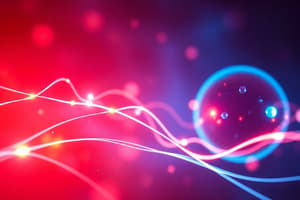Podcast
Questions and Answers
Which atomic element has an electron configuration of $1s^2 2s^2 2p^1$?
Which atomic element has an electron configuration of $1s^2 2s^2 2p^1$?
- Magnesium
- Boron (correct)
- Beryllium
- Lithium
What is the maximum number of electrons that can occupy the 2p subshell?
What is the maximum number of electrons that can occupy the 2p subshell?
- 10
- 6 (correct)
- 14
- 2
Which element possesses a completely filled outer shell, indicating stability?
Which element possesses a completely filled outer shell, indicating stability?
- Helium (correct)
- Carbon
- Aluminum
- Sodium
What is the principal quantum number for the outermost electrons in Sodium?
What is the principal quantum number for the outermost electrons in Sodium?
Which electron configuration correctly represents Magnesium?
Which electron configuration correctly represents Magnesium?
Which sublevel can hold a maximum of 6 electrons?
Which sublevel can hold a maximum of 6 electrons?
In the electron configuration of an element, which of the following indicates the highest energy level occupied by electrons?
In the electron configuration of an element, which of the following indicates the highest energy level occupied by electrons?
Which of the following terms describes the highest occupied energy level in an atom?
Which of the following terms describes the highest occupied energy level in an atom?
What is the maximum number of electrons that can occupy the K shell?
What is the maximum number of electrons that can occupy the K shell?
Which element has the electron configuration of 1s2 2s2 2p6 3s2 3p6 3d6 4s2?
Which element has the electron configuration of 1s2 2s2 2p6 3s2 3p6 3d6 4s2?
Flashcards are hidden until you start studying
Study Notes
Electron Energy States
- Electrons fill discrete energy states, preferring the lowest available state.
- Energy levels are organized into shells: K shell (n=1), L shell (n=2), M shell (n=3), N shell (n=4).
- Each shell can hold a specific number of electrons:
- s = 2
- p = 6
- d = 10
- f = 14
Electronic Configuration
- Example configuration for Iron (Fe), atomic number 26: 1s² 2s² 2p⁶ 3s² 3p⁶ 3d⁶ 4s².
- Valence electrons are the outermost electrons influencing chemical behavior.
Stability of Electron Configuration
- Most elements have unstable electron configurations, leading to reactivity.
- Stable configurations occur when valence shells are fully occupied.
- Stable configurations examples:
- Helium (He, atomic #2): 1s²
- Neon (Ne, atomic #10): 1s² 2s² 2p⁶
- Argon (Ar, atomic #18): 1s² 2s² 2p⁶ 3s² 3p⁶
- Krypton (Kr, atomic #36): 1s² 2s² 2p⁶ 3s² 3p⁶ 3d¹⁰ 4s² 4p⁶
Valence Shells
- Valence shells typically do not fill completely, impacting stability:
- K shell (n=1): 2 electrons
- L shell (n=2): 8 electrons (2 in s, 6 in p)
- M shell (n=3): 18 electrons (2 in s, 6 in p, up to 10 in d)
- N shell (n=4): 32 electrons (2 in s, 6 in p, up to 10 in d, up to 14 in f)
Summary of Element Electron Configurations
- Hydrogen (H, atomic #1): 1s¹
- Helium (He, atomic #2): 1s² (stable)
- Lithium (Li, atomic #3): 1s² 2s¹
- Beryllium (Be, atomic #4): 1s² 2s²
- Boron (B, atomic #5): 1s² 2s² 2p¹
- Carbon (C, atomic #6): 1s² 2s² 2p²
- Neon (Ne, atomic #10): 1s² 2s² 2p⁶ (stable)
- Sodium (Na, atomic #11): 1s² 2s² 2p⁶ 3s¹
- Magnesium (Mg, atomic #12): 1s² 2s² 2p⁶ 3s²
- Aluminum (Al, atomic #13): 1s² 2s² 2p⁶ 3s² 3p¹
- Argon (Ar, atomic #18): 1s² 2s² 2p⁶ 3s² 3p⁶ (stable)
- Krypton (Kr, atomic #36): 1s² 2s² 2p⁶ 3s² 3p⁶ 3d¹⁰ 4s² 4p⁶ (stable)
Studying That Suits You
Use AI to generate personalized quizzes and flashcards to suit your learning preferences.




